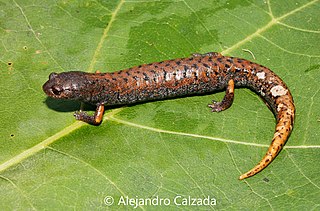Pseudoeurycea lineola, commonly known as the Veracruz worm salamander or Mexican slender salamander, is a species of salamander in the family Plethodontidae. It is endemic to the Sierra Madre Oriental near Cuautlapan, in the east-central Veracruz, Mexico, at elevations of 800–1,250 m (2,620–4,100 ft) above sea level. Molecular evidence suggests that it consists of two distinct species. It was the type species of genus Lineatriton.
Pseudoeurycea orchileucos, commonly known as the Sierra de Juárez worm salamander, is a species of salamander in the family Plethodontidae. It is endemic to Oaxaca, Mexico, where it is known from the northern slopes of Sierra de Juarez at elevations of 800–1,390 m (2,620–4,560 ft) above sea level.
Pseudoeurycea orchimelas, commonly known as the San Martin worm salamander, is a species of salamander in the family Plethodontidae. It is endemic to Veracruz, Mexico, where it is known from the Sierra de los Tuxtlas at elevations of 100–1,300 m (330–4,270 ft) above sea level.
Pseudoeurycea amuzga, which has been given the common name of Sierra de Malinaltepec salamander, is a species of salamander in the family Plethodontidae. It is endemic to Mexico and known only from Sierra de Malinaltepec, a part of Sierra Madre del Sur in the Guerrero state.
Pseudoeurycea anitae, commonly known as Anita's false brook salamander or Anita's salamander, is a species of salamander in the family Plethodontidae. It is endemic to Mexico and only known from its type locality near San Vicente Lachixío, Oaxaca, in the Sierra Madre del Sur mountains, at about 2,100 m (6,900 ft) above sea level. The specific name anitae honors Anita Smith, a resident of Oaxaca City who helped Charles Mitchill Bogert when he was collecting in the surroundings of the city. This species might already be extinct.
Pseudoeurycea aquatica, which has been given the common name of aquatic salamander is a species of salamander in the family Plethodontidae. It is endemic to Mexico and only known from its type locality near Totontepec Villa de Morelos, Oaxaca.

Pseudoeurycea cochranae is a species of salamander in the family Plethodontidae. It is endemic to the highlands of central and west-central Oaxaca, Mexico.
Pseudoeurycea conanti is a species of salamander in the family Plethodontidae. It is endemic to Oaxaca, Mexico.
Pseudoeurycea goebeli is a species of salamander in the family Plethodontidae. It is found in Guatemala and Mexico. Its natural habitat is subtropical or tropical moist montane forests. It is threatened by habitat loss.
Pseudoeurycea juarezi is a species of salamander in the family Plethodontidae, endemic to Mexico.
Pseudoeurycea melanomolga, commonly known as the black false brook salamander or black salamander, is a species of salamander in the family Plethodontidae. It is endemic to Mexico and known from the surroundings of the Cofre de Perote in west-central Veracruz as well as from two localities in the adjacent northeast Puebla.

Pseudoeurycea mystax is a species of salamander in the family Plethodontidae. It is endemic to Mexico and only known from the area of its type locality near Ayutla, Oaxaca. Its common name is mustache false brook salamander or mustached false brook salamander. The specific name refers to the whitish protuberances on the lips that resemble a mustache in the frontal view of the male holotype.
Pseudoeurycea nigromaculata, commonly known as the black-spotted salamander or black-spotted false brook salamander is a species of salamander in the family Plethodontidae. It is endemic to Veracruz, Mexico, and known from Cerro Chicahuaxtla ) in Cuatlalpan and from Volcán San Martín at elevations of 1,200–1,300 m (3,900–4,300 ft). These separate populations likely represent distinct species.
The ridge tail salamander, also known as ridge-tailed salamander is a species of salamander in the family Plethodontidae. It is endemic to Oaxaca, Mexico, and only known from the area of its type locality.
The muscular salamander is a species of salamander in the family Plethodontidae. It is endemic to Mexico.
Aquiloeurycea praecellens, also known as the admirable false brook salamander, is a species of salamander in the family Plethodontidae. It is endemic to the Sierra Madre Oriental in Veracruz, Mexico. Its natural habitat is lowland tropical moist forest where it is threatened by habitat loss.
Pseudoeurycea smithi, commonly known as Smith's false brook salamander, is a species of salamander in the family Plethodontidae. It is endemic to certain mountainous regions of Mexico. Its natural habitat is subtropical or tropical moist montane forests. It is threatened by habitat loss.
Pseudoeurycea tlahcuiloh, commonly known as the green-flecked salamander, is a species of salamander in the family Plethodontidae. It is endemic to Mexico.
Pseudoeurycea unguidentis is a species of salamander in the family Plethodontidae. It is endemic to northern Oaxaca, Mexico, where it is known from its type locality, Cerro San Felipe, and some other mountains, although the identity of animals from these other locations is uncertain. Its common names are claw-toothed salamander, clawtooth false brook salamander, and clawtoed false brook salamander.
Pseudoeurycea werleri is a species of salamander in the family Plethodontidae. Its common name is Werler's false brook salamander or simply Werler's salamander. It is endemic to the Sierra de los Tuxtlas range in southern Veracruz state, Mexico. Its natural habitats are tropical rainforests and cloud forests where it lives in moss mats. It is threatened by habitat loss caused by subsistence agriculture, logging, and human settlement.


